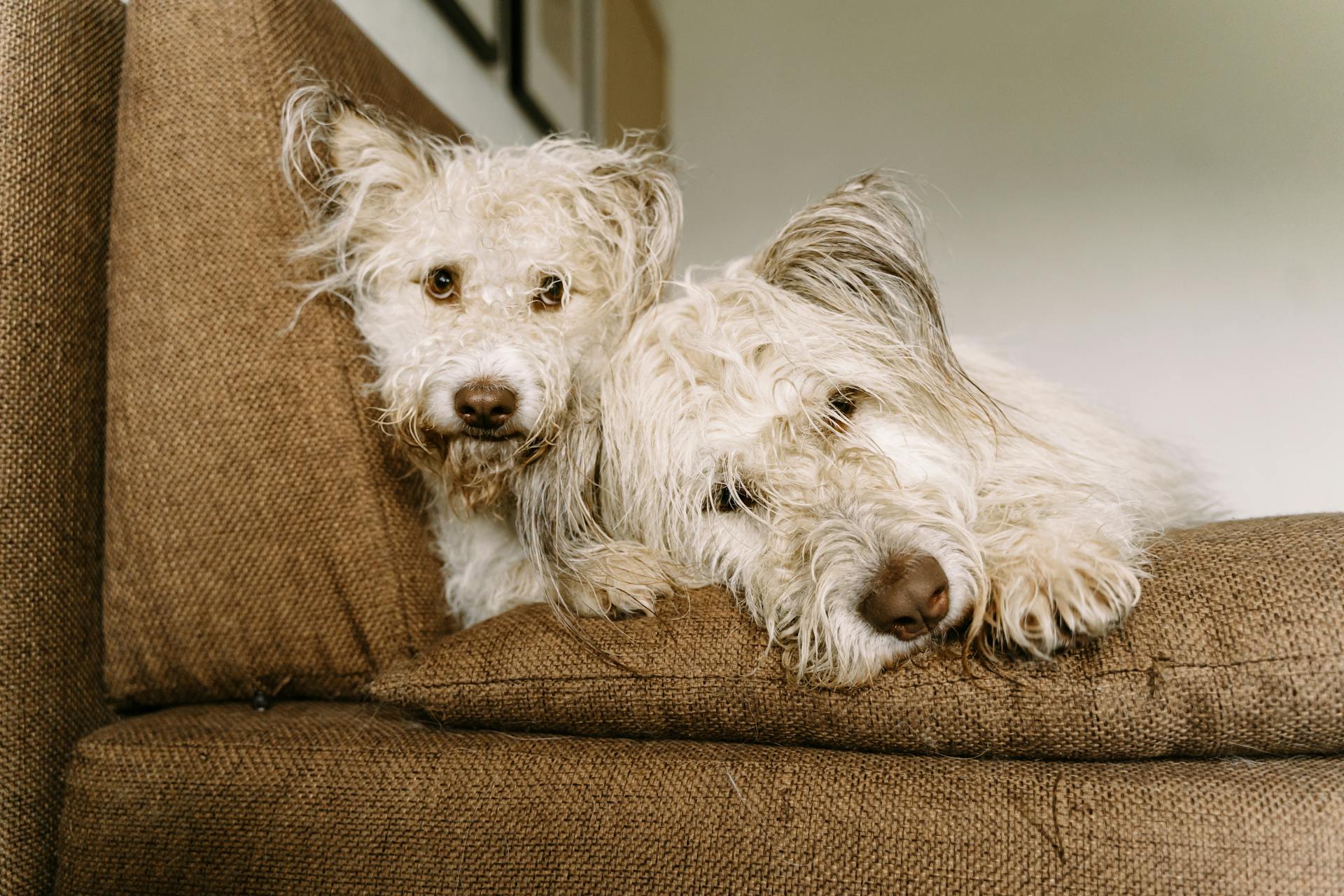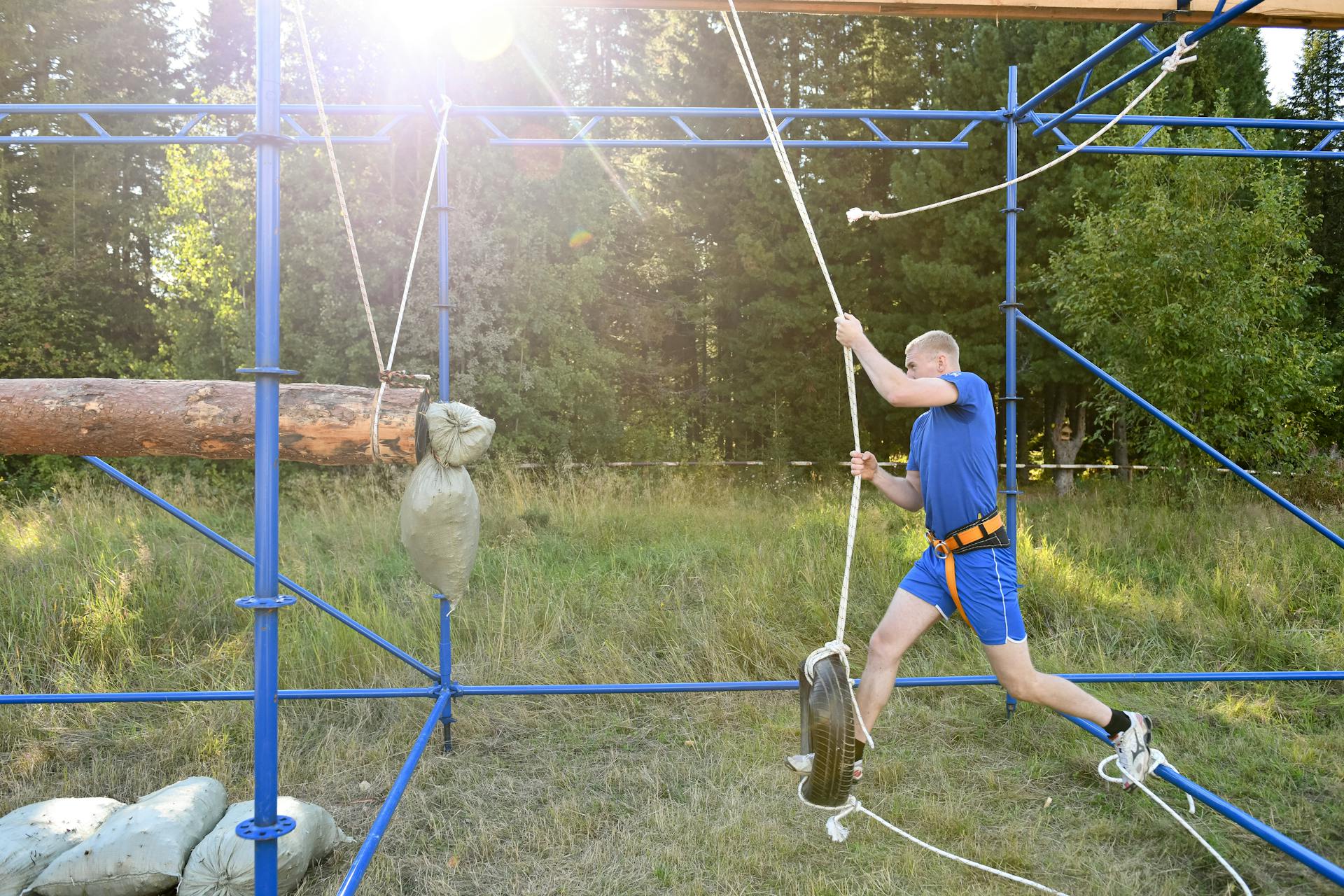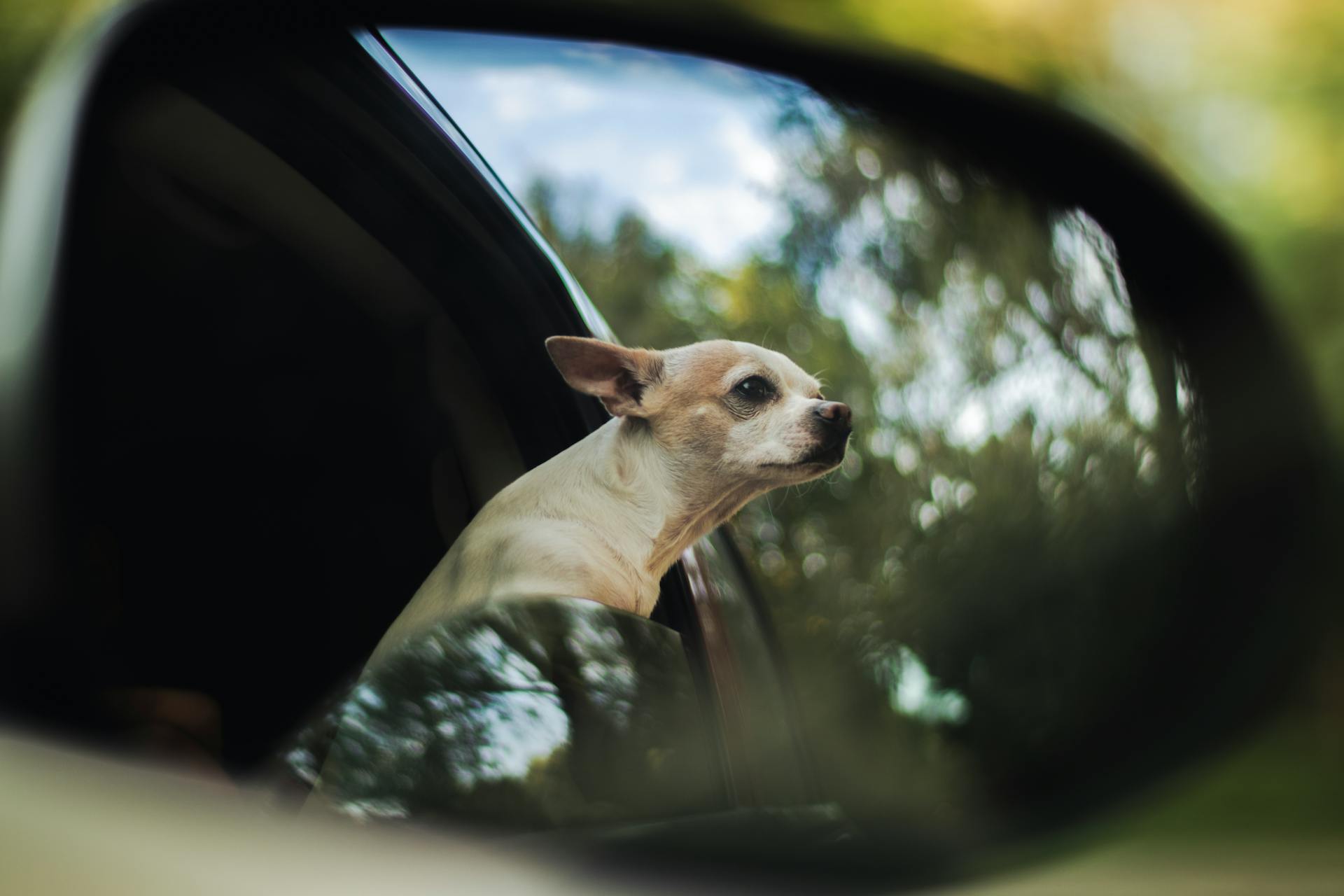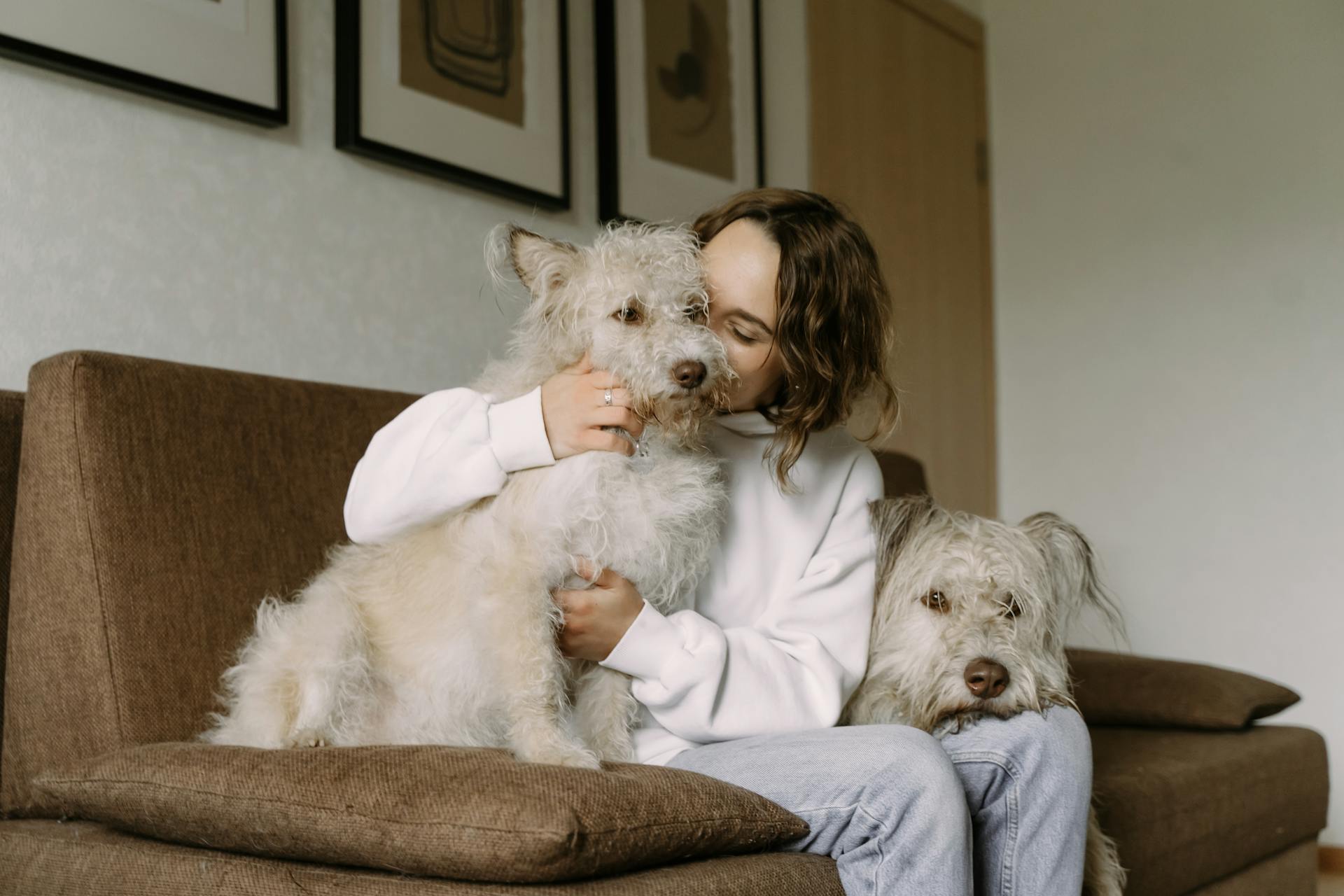
Recognizing the signs of fear, anxiety, and stress in dogs is crucial for their well-being. A dog's body language can be a clear indicator of their emotional state, with signs such as a tucked tail, raised hackles, and avoidance behaviors.
Dogs can exhibit different types of fearful reactions, including avoidance, freezing, and flight. These reactions can be triggered by various stimuli, including loud noises, new environments, and strangers.
The Fear Anxiety Stress Scale (FASS) is a tool used to assess a dog's emotional state and identify the underlying causes of their fear, anxiety, or stress. By using the FASS, dog owners and trainers can develop a plan to help their dog overcome these issues.
With patience, consistency, and positive reinforcement training, dogs can learn to manage their fear, anxiety, and stress.
See what others are reading: Can Stress Cause Pancreatitis in Dogs
Clinical Signs and Causes
Clinical signs of dog anxiety and fear can be quite varied, but some common ones include trembling, tail-tucking, hiding, reduced activity, and passive escape behaviors.
These behaviors can be a sign that your dog is experiencing mild fears. In more severe cases, you may see panting, pacing, active escape behavior, and increased out-of-context, potentially injurious motor activity.
Panic and sympathetic autonomic nervous system activity, including diarrhea, can also be symptoms of anxiety in dogs. In some cases, you may even notice lesions secondary to licking and biting their own body, or tail-chasing and circling.
The causes of fear and anxiety in dogs are often complex, but some common triggers include being forced into an unfamiliar and frightening experience, being deprived of social and environmental exposure until 14 weeks of age, and having a history of not being able to escape or get away from the stimulus causing the phobia.
Age-related health conditions, such as dementia, can also contribute to anxiety and fear in dogs. Additionally, any illness or painful physical condition can increase anxiety and contribute to the development of fears, phobias, and anxieties.
Clinical Signs
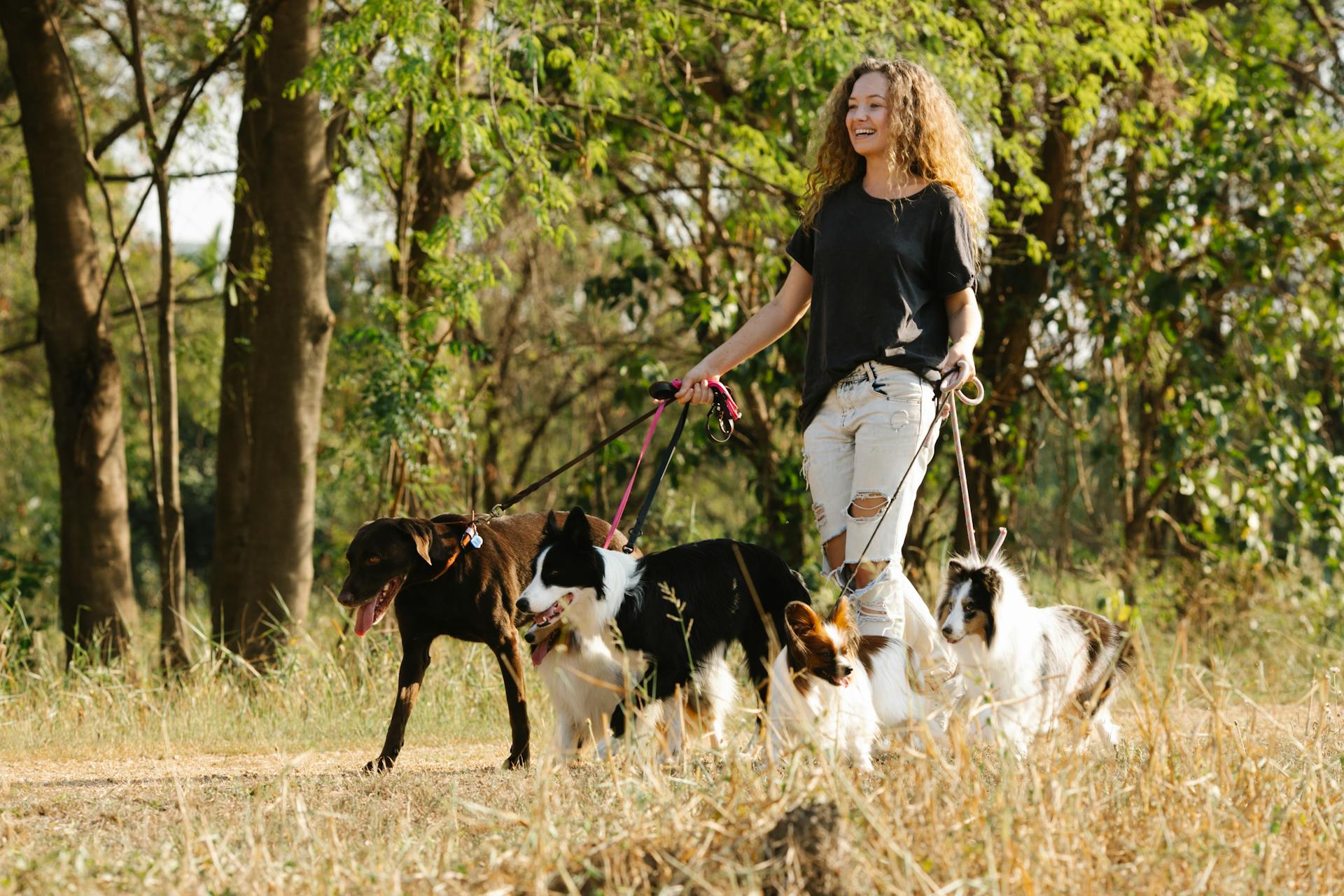
Clinical signs of dog anxiety and fear can vary in severity, but there are some common indicators to look out for. Trembling, tail-tucking, hiding, reduced activity, and passive escape behaviors are all possible signs of mild fears.
Panting, pacing, active escape behavior, and increased out-of-context, potentially injurious motor activity can indicate a more severe case of fear or anxiety.
Diarrhea is a sign of sympathetic autonomic nervous system activity, which can be a result of stress or anxiety in dogs.
Lesions secondary to licking and biting their own body can be a physical manifestation of anxiety in dogs.
Tail-chasing and circling are also common behaviors exhibited by dogs experiencing anxiety or fear.
Causes
Dogs can develop fear and anxiety issues due to a variety of reasons. One common cause is being forced into an unfamiliar and frightening experience.
Forcing your dog into a new situation without proper introduction and socialization can lead to anxiety. This can be as simple as introducing a new pet or person into the home without a gradual introduction.
A unique perspective: Dogs without Separation Anxiety
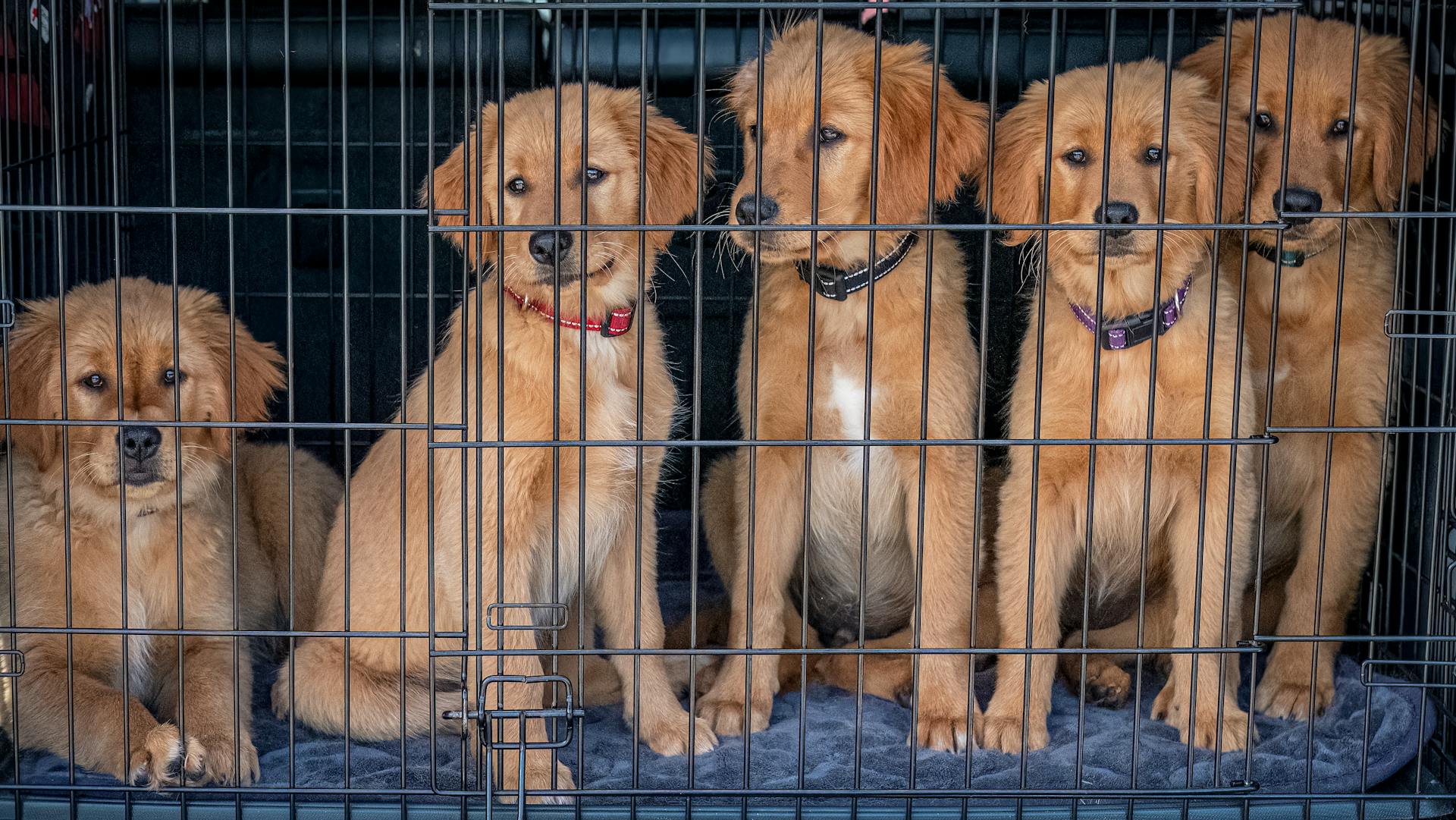
Being deprived of social and environmental exposure until 14 weeks of age can also contribute to anxiety in dogs. This is because puppies learn important social skills during this critical period.
Some dogs may develop phobias and panic due to a history of not being able to escape or get away from the stimulus causing the phobia and panic. For example, being locked in a crate for extended periods can lead to anxiety.
Separation anxiety is another common cause of fear and anxiety in dogs. This can be triggered by a history of abandonment, having multiple owners over time, or being rehomed or experiencing prior neglect.
Any illness or painful physical condition can increase anxiety and contribute to the development of fears, phobias, and anxieties.
Some common causes of anxiety in dogs include:
- Forced exposure to unfamiliar and frightening experiences
- Deprivation of social and environmental exposure until 14 weeks of age
- History of not being able to escape or get away from the stimulus causing the phobia and panic
- Separation anxiety due to history of abandonment, multiple owners, or prior neglect
- Illness or painful physical conditions
Aging changes, infectious disease, and toxic conditions can also lead to behavioral problems, including fears, phobias, and anxieties.
Freezing
Freezing is a critical sign to recognize in dogs. It can be a warning sign that your dog is so stressed they can't handle the situation.
Freezing can sometimes be mistaken for "submission", but modern dog training practices reveal it's actually a sign of shutting down. This is a common response in stressful situations.
In a training context, freezing can be a sign that your dog needs a break or a change in environment. It's essential to recognize this sign and take action to prevent further stress.
Diagnosing and Treating
Diagnosing fear and anxiety in dogs requires a thorough examination by your veterinarian to rule out underlying medical conditions such as brain, thyroid, or adrenal disease. Blood tests will confirm or rule out these conditions.
Your veterinarian will make recommendations based on your dog's individual fear trigger, and may refer you to a veterinary behaviorist for further guidance. Prescription medications may be prescribed to help manage anxiety, but they're typically implemented only as a last resort in severe cases.
The treatment process for fear and anxiety in dogs can take several years, and may require long-term management techniques and behavior modification exercises. Hospitalization may be necessary if your dog has extreme panic and separation anxiety that needs to be protected until medications can become effective.
Diagnosing

Diagnosing can be a crucial step in understanding what's going on with your furry friend. Your veterinarian will first want to rule out other conditions that might be causing the behavior, such as brain, thyroid or adrenal disease.
Blood tests are often used to rule out or confirm possible underlying medical conditions.
Treating
Treating extreme fear and anxiety in dogs can be a long-term process, often taking several years to show significant improvement. Most forms of treatment will be done over the long-term, and could possibly span several years.
If your veterinarian recommends medication, it's usually prescribed in addition to behavior modification exercises. Keep in mind that prescription medications are not right for every pet and are typically implemented only as a last resort in severe instances.
The minimum treatment time averages four to six months. Your veterinarian will make recommendations based on your individual dog's fear trigger, or they may refer you to a veterinary behaviorist for further guidance.
In severe cases, hospitalization may be necessary to protect your dog from self-inflicted physical injury until medications can become effective. This can take days to weeks, so it's essential to be prepared for this possibility.
Desensitization and Counter-Conditioning
Desensitization and counter-conditioning are effective ways to treat fear, phobia, or anxiety in dogs if started early. The goal is to decrease the reaction to a specific stimulus.
Desensitization involves repeated, controlled exposure to the stimulus at a low intensity that doesn't trigger fear or anxiety. This can be done by gradually increasing the exposure to the stimulus over time.
Counter-conditioning trains the dog to perform a positive behavior in place of fear or anxiety. For example, teaching your dog to sit and stay and rewarding them for it.
You can redirect your dog's attention to a positive behavior when they're in a situation that usually triggers fear or anxiety. This can help calm them down and prevent a panic attack.
Desensitization and Counter-Conditioning
Desensitization and counter-conditioning are effective if the fear or anxiety is treated early. The goal is to decrease the reaction to a specific stimulus.
Desensitization is a process of repeated, controlled exposure to the stimulus that usually causes a fearful or anxious response. This is done at a low intensity so the dog doesn't respond with fear or anxiety.
You can teach your dog to perform a positive behavior in place of fear or anxiety through counter-conditioning. This involves training your dog to sit and stay, and rewarding them when they do.
The signs of an oncoming anxiety attack are subtle in dogs. You should learn to recognize your dog's physical signs of fear, phobias, and anxiety so you can intervene before your dog panics.
Consider reading: Signs of Fear in Dogs
The Traffic Lights
Understanding the Traffic Lights of Fear and Anxiety is crucial when it comes to recognizing the signs of stress in your dog.
Dogs may not always take treats when they're feeling anxious.
Body posture can become stiff, and they might look away, indicating they're not feeling their usual self.
Fiddle signs can start to appear, such as licking lips, yawning, body shaking, sniffing, mounting, jumping, pacing, putting a paw up, teeth chattering, and barking.
Hypervigilance is a common sign, where your dog becomes very aware of their environment and looks everywhere.
As anxiety escalates, your dog's body might start shaking, their posture becomes very rigid, and their face becomes tight with a furrowed brow and staring eyes.
At this point, they may become frozen by fear, unable to move, or they might try to flee and hide.
Additional reading: What to Feed Dogs When Out of Dog Food
Frequently Asked Questions
What is the fas scale for dogs?
The FAS Scale for dogs is a standardized tool used to assess and record their level of fear, anxiety, and stress, helping you identify areas for improvement and provide tailored support. By using this scale, you'll gain valuable insights to create a more comfortable and secure environment for your furry friend.
What is fas 5 syndrome in dogs?
FAS 5 syndrome in dogs refers to a severe behavioral condition characterized by aggression, such as growling, lunging, and snarling. It's essential to understand the signs and symptoms of FAS 5 to provide proper care and treatment for affected dogs.
What is the stress scale for dogs?
The Lincoln Canine Anxiety Scale (LCAS) is a reliable tool to measure a dog's anxiety triggered by a specific stimulus. It helps identify and quantify a dog's stress levels in response to individual triggers.
Sources
- https://www.petmd.com/dog/conditions/behavioral/c_dg_fears_phobia_anxiety
- https://www.akc.org/expert-advice/training/how-to-tell-if-your-dog-is-stressed/
- https://www.smithsonianmag.com/science-nature/firework-fear-why-your-dog-does-or-doesnt-react-and-how-you-should-180975182/
- https://pattonvethospital.com/blog/98095-recognizing-signs-of-fear-anxiety-and-stress-in-dogs
- https://www.furlifevet.com.au/the-pet-stress-scale/
Featured Images: pexels.com
